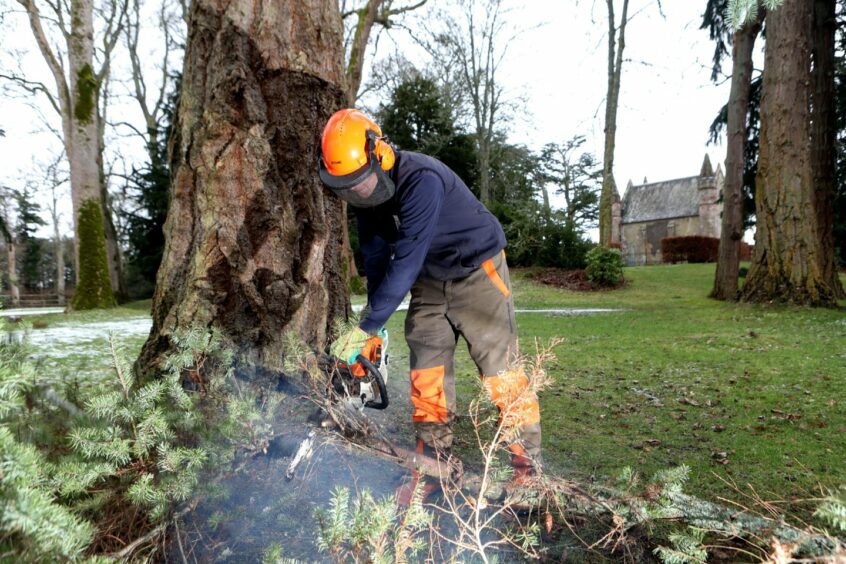There’s no doubt, being a gardener can be at times as much frustrating as it is satisfying.
This winter at Scone Palace, where I’m head gardener, myself and the team had a programme of works all planned out.
This would have seen improvements in some areas, a proper path in a generally unvisited but lovely, wooded glen.
Also bringing back to life other parts, creating new beds in the walled garden as part of development works in here.
Then the big storm came
Then Storm Arwen blew through at the end of November. It put a dozen trees with around 2,000 years of living between them onto the ground and destroyed all that grew beneath them.
All those plans had to be chucked out the potting shed window.
Instead, all our efforts since then and until grass cutting season starts in the middle of March, have been focused on tidying the garden up.
We’re not the only gardening team to be facing these challenges either, as I can see from the social media posts at other gardens around the country.
Scott Smith, the head gardener of the stunning Renaissance walled garden at Pitmedden in Aberdeenshire, recently commented on how his team of gardening staff and volunteers were still clearing brash from the trees covering their immaculate lawns, 75 days after that first storm.
We feel your pain down in Scone.
On top of the disappointment of losing such amazing trees, these works that hopefully would have made the garden better, evolving, will have to wait at least another year now.
Growing season is busy season
Once the growing season starts we will be so busy keeping the beds looking smart, the lawns neat and growing veg for the kitchen garden to be constructing any new paths or lifting turf to make new beds.
There are some jobs we have in the grounds of the Palace that simply cant wait another year.
We have clumps of old Rhododendron that don’t really bring much to the garden with their flower but act as a great windbreak and foil for other plantings.
The trouble is they are now getting so big they’re becoming overgrown and blocking paths.
I really wanted to tackle them last year and restore some order, but as we were under lockdowns there wasn’t any team to carry out these works.
I dread to think just how bad they will get and ultimately how big these shrubs will be if another year goes by where we can’t get to them.
It’s a measure of our team at Scone Palace – who I cant thank enough for their efforts – and of all the other gardening teams facing similar situations, that we are still looking to achieve these works during this winter season.
And they say us gardeners don’t do much at this time of year!
The Queen’s Green Canopy
We’re still managing to get a couple of little projects carried out and are very proud to be contributing to the Queen’s Green Canopy, a unique tree planting initiative across the UK to mark Her Majesty’s Platinum Jubilee.
No matter what size of garden you have this is something we can all take part in.
There is at least one tree able to fit into even the smallest of gardens.
Our planting consists of seven pink and white, winter flowering cherries planted together to make one, big display.
Not all of the trees were newly bought, having been grown in containers, three were already growing in the gardens and moved to their new home.
I think we’ve all been there. A few years after planting a new shrub we realise it doesn’t look right or is getting too big for space.
That may have led to the drastic action of digging the shrub out completely but if it’s a treasured plant or you have the room then it’s worth taking the calculated risk of moving your plant to a better site in a process known as ‘transplanting’.
The time for moving plants
During late October to March is the time we can move deciduous trees and shrubs, that is those that lose their leaves over winter.
With an evergreen, I like to wait until the end of winter before shifting, to catch that point just as the soil is warming up again.
The theory is the plants roots can re establish themselves quicker after that shock, thus increasing the chances of success.
Prepare the new site in advance, making sure the planting hole is large enough, and replant at the same depth which is important.
If it’s a spreading shrub, loose branches can be carefully tied in to make the task easier, dig a circular trench around a foot wide where the shrub canopy would be, slowly digging under the plant making a big a root ball as possible.
A wee tip
A wee tip here. Digging a trench is the best way to avoid snapping your spade in two. Remember spades are for digging and not for levering.
This was a piece of good advice given to me by a friend.
Aftercare is key, ensuring plants are watered in thoroughly after planting and during dry spells.
Follow this up by adding a thick layer of mulch such as leaf mould or garden compost.













